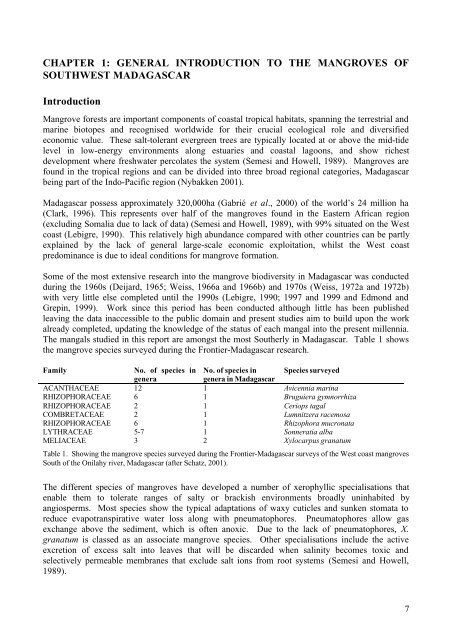Mangrove biodiversity survey south of the Onilahy River - Frontier ...
Mangrove biodiversity survey south of the Onilahy River - Frontier ...
Mangrove biodiversity survey south of the Onilahy River - Frontier ...
You also want an ePaper? Increase the reach of your titles
YUMPU automatically turns print PDFs into web optimized ePapers that Google loves.
CHAPTER 1: GENERAL INTRODUCTION TO THE MANGROVES OF<br />
SOUTHWEST MADAGASCAR<br />
Introduction<br />
<strong>Mangrove</strong> forests are important components <strong>of</strong> coastal tropical habitats, spanning <strong>the</strong> terrestrial and<br />
marine biotopes and recognised worldwide for <strong>the</strong>ir crucial ecological role and diversified<br />
economic value. These salt-tolerant evergreen trees are typically located at or above <strong>the</strong> mid-tide<br />
level in low-energy environments along estuaries and coastal lagoons, and show richest<br />
development where freshwater percolates <strong>the</strong> system (Semesi and Howell, 1989). <strong>Mangrove</strong>s are<br />
found in <strong>the</strong> tropical regions and can be divided into three broad regional categories, Madagascar<br />
being part <strong>of</strong> <strong>the</strong> Indo-Pacific region (Nybakken 2001).<br />
Madagascar possess approximately 320,000ha (Gabrié et al., 2000) <strong>of</strong> <strong>the</strong> world’s 24 million ha<br />
(Clark, 1996). This represents over half <strong>of</strong> <strong>the</strong> mangroves found in <strong>the</strong> Eastern African region<br />
(excluding Somalia due to lack <strong>of</strong> data) (Semesi and Howell, 1989), with 99% situated on <strong>the</strong> West<br />
coast (Lebigre, 1990). This relatively high abundance compared with o<strong>the</strong>r countries can be partly<br />
explained by <strong>the</strong> lack <strong>of</strong> general large-scale economic exploitation, whilst <strong>the</strong> West coast<br />
predominance is due to ideal conditions for mangrove formation.<br />
Some <strong>of</strong> <strong>the</strong> most extensive research into <strong>the</strong> mangrove <strong>biodiversity</strong> in Madagascar was conducted<br />
during <strong>the</strong> 1960s (Deijard, 1965; Weiss, 1966a and 1966b) and 1970s (Weiss, 1972a and 1972b)<br />
with very little else completed until <strong>the</strong> 1990s (Lebigre, 1990; 1997 and 1999 and Edmond and<br />
Grepin, 1999). Work since this period has been conducted although little has been published<br />
leaving <strong>the</strong> data inaccessible to <strong>the</strong> public domain and present studies aim to build upon <strong>the</strong> work<br />
already completed, updating <strong>the</strong> knowledge <strong>of</strong> <strong>the</strong> status <strong>of</strong> each mangal into <strong>the</strong> present millennia.<br />
The mangals studied in this report are amongst <strong>the</strong> most Sou<strong>the</strong>rly in Madagascar. Table 1 shows<br />
<strong>the</strong> mangrove species <strong>survey</strong>ed during <strong>the</strong> <strong>Frontier</strong>-Madagascar research.<br />
Family<br />
No. <strong>of</strong> species in No. <strong>of</strong> species in Species <strong>survey</strong>ed<br />
genera<br />
genera in Madagascar<br />
ACANTHACEAE 12 1 Avicennia marina<br />
RHIZOPHORACEAE 6 1 Bruguiera gymnorrhiza<br />
RHIZOPHORACEAE 2 1 Ceriops tagal<br />
COMBRETACEAE 2 1 Lumnitzera racemosa<br />
RHIZOPHORACEAE 6 1 Rhizophora mucronata<br />
LYTHRACEAE 5-7 1 Sonneratia alba<br />
MELIACEAE 3 2 Xylocarpus granatum<br />
Table 1. Showing <strong>the</strong> mangrove species <strong>survey</strong>ed during <strong>the</strong> <strong>Frontier</strong>-Madagascar <strong>survey</strong>s <strong>of</strong> <strong>the</strong> West coast mangroves<br />
South <strong>of</strong> <strong>the</strong> <strong>Onilahy</strong> river, Madagascar (after Schatz, 2001).<br />
The different species <strong>of</strong> mangroves have developed a number <strong>of</strong> xerophyllic specialisations that<br />
enable <strong>the</strong>m to tolerate ranges <strong>of</strong> salty or brackish environments broadly uninhabited by<br />
angiosperms. Most species show <strong>the</strong> typical adaptations <strong>of</strong> waxy cuticles and sunken stomata to<br />
reduce evapotranspirative water loss along with pneumatophores. Pneumatophores allow gas<br />
exchange above <strong>the</strong> sediment, which is <strong>of</strong>ten anoxic. Due to <strong>the</strong> lack <strong>of</strong> pneumatophores, X.<br />
granatum is classed as an associate mangrove species. O<strong>the</strong>r specialisations include <strong>the</strong> active<br />
excretion <strong>of</strong> excess salt into leaves that will be discarded when salinity becomes toxic and<br />
selectively permeable membranes that exclude salt ions from root systems (Semesi and Howell,<br />
1989).<br />
7
















